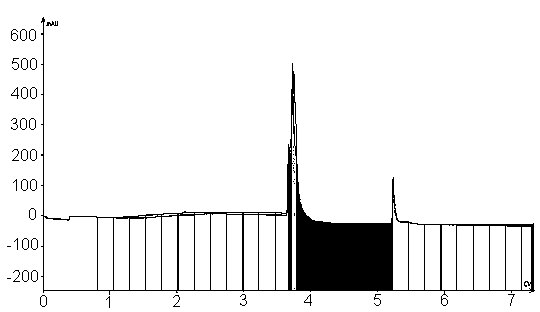Method for separating base oil family composition
A separation method and base oil technology, applied in material separation, base material, petroleum industry, etc., can solve the problems of large solvent consumption and complicated separation methods
- Summary
- Abstract
- Description
- Claims
- Application Information
AI Technical Summary
Problems solved by technology
Method used
Image
Examples
Embodiment 1
[0018] Accurately weigh 100.00 grams of lubricating oil base oil I, then add 50.00 grams of petroleum ether for dilution. Weigh 750.00 g of silica gel (200-300 mesh), add it into the chromatographic column (10 cm in diameter, 60 cm in length) with a solid addition funnel, and beat it while adding to make it compact. After the chromatographic column was thoroughly rinsed with petroleum ether, the diluted oil sample was directly sucked into the sample. Preparative liquid chromatography was separated in the order of non-polar solvent (n-hexane 1875 ml), medium polar solvent (chloroform 1500 ml) and polar solvent (isopropanol 1500 ml). The ultraviolet detector collects automatically, collects the product according to the analysis result of the ultraviolet detector, and finally divides it into three parts, namely non-polar solvent eluate, medium polar eluate and strong polar eluate. The solvents of the three eluates were evaporated under reduced pressure with a rotary evaporator t...
Embodiment 2
[0025] Same as in [Example 1], the group composition of the lubricating base oil II was separated by liquid phase preparative chromatography. Only the non-polar solvent used is n-heptane in an amount of 2000 milliliters; the medium polar solvent is chloroform in an amount of 1500 milliliters; the polar solvent is n-propanol in an amount of 1500 milliliters. Obtain the total saturated hydrocarbon content, the total aromatic hydrocarbon content and the total gum mass as shown in Table 3.
[0026] table 3
[0027] project total saturated hydrocarbon Total Aromatics Total Glue Quality Mass (grams) 98.2 0.108 0.096 The proportion(%) 99.8 0.110 0.098
[0028] As can be seen from Table 3, the total recovery rate is as high as 98.4%. 。 In the same way, [Example 2] was repeated 3 times in parallel, and the average relative standard deviation can be calculated to be 2.75%. Comparing the results with the full mass spectrum results (only accurate to ...
PUM
 Login to View More
Login to View More Abstract
Description
Claims
Application Information
 Login to View More
Login to View More - R&D
- Intellectual Property
- Life Sciences
- Materials
- Tech Scout
- Unparalleled Data Quality
- Higher Quality Content
- 60% Fewer Hallucinations
Browse by: Latest US Patents, China's latest patents, Technical Efficacy Thesaurus, Application Domain, Technology Topic, Popular Technical Reports.
© 2025 PatSnap. All rights reserved.Legal|Privacy policy|Modern Slavery Act Transparency Statement|Sitemap|About US| Contact US: help@patsnap.com



